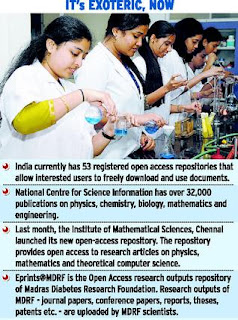2012-13 was declared the year of science by Prime Minister Manmohan Singh last year, and there is a lot of effort being made all over the country to not only intensify the quantity and quality of research but also ensure greater access for all. For instance, IIT-Madras plans to make available its research papers in all disciplines online, in the public domain. The institute already provides e-learning through online web and video courses in engineering, science and humanities streams through NPTEL.
The attempt now is to convince faculty members to upload their research papers into the institution's repository, says Mangala Sunder Krishnan, Web Coordinator (NPTEL). The move will not only benefit students and faculty members but will also help the circle of knowledge to be complete, he says.
What IIT- Madras plans to do is follow an Open Access policy that would make the access of journals and scientific research public and many other educational organisations plan to follow suite. “Most research publications stay locked up in commercial journals and are inaccessible to many. Open Access is the best way to ensure that research produced in the developing world gets wider visibility,” says Francis Jayakanth, a library-trained scientific assistant based at the National Centre for Science Information, the information centre of the Indian Institute of Science, Bangalore. Mr. Jayakanth has been instrumental in creating an institutional repository ePrints@IISc that has over 32,000 publications by researchers.
Subbiah Arunachalam, distinguished fellow at the Centre for Internet and Society explains: “A research produced by the Tuberculosis Research Centre in Chennai which would be of great relevance to researchers, say in a university in Maharashtra, may not be even noticed by the scientists there. Both groups receive funds from the same source - Government of India - and yet what one does is not easily accessible to the other. “Open Access would bridge that gap and make information available to everyone,” he says.
Open Access repositories would help authors place their papers in an interoperable institutional open access archive and anyone with an Internet connection can access it. Researchers say that in most reputed journals, it takes almost six months to get a paper published, and most insist that the paper is removed from the internal repository of the author's institution once it is published. “But 70 per cent of the publishers are now fine with the authors taking the pre-print of their paper uploaded in the repository. And since in open access, every thing is peer reviewed, the quality is never compromised,” says Mr. Jayakanth.
While institutions such as IIT- Madras subscribe to over 2,000 journals, many colleges under Anna University and University of Madras have access to just about 1,500 journals. “There is almost Rs.10 -12 lakh that the institution spends on journal subscriptions so unless there is funding, many self-financed colleges prefer not to subscribe to journals and go for a few mandatory ones prescribed by AICTE. Students and researchers have no way to acquaint themselves with recent updates,” says D. Krishnan, professor, Anna University.
Even if you go through consortiums, you have to spend Rs.20 lakh which many smaller R&D organisations cannot afford to, adds P. Ramamoorthy, librarian at Sameer- Centre for Electromagnetics, a government-funded research agency. “The restrictions imposed by many commercial publishers do not allow one to legally share the published output of his result with his colleague. Open access will relive authors of such hassles,” he says.


No comments:
Post a Comment